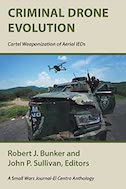Postscript: Anticipating Future Threats of Unmanned Systems
James J. Torrence
Jerusalem. Israel, August 2021

Editor’s note: This essay appeared as the postscript to Robert J. Bunker and John P. Sullivan, Eds., Criminal Drone Evolution: Cartel Weaponization of Aerial IEDs. A Small Wars Journal–Anthology. Bloomington: Xlibris, 2021
As I reflected on what I learned after reading this anthology, I could not help but think we are at the beginning of an unmanned systems revolution. Dr. Bunker and Dr. Sullivan are always on the forefront of capturing use cases of unmanned systems by drug cartels and non-state actors. Their work also shows that law enforcement and military personnel are often surprised by the innovations and uses of unmanned systems by criminal organizations. There are myriad lessons one can learn from this book, but I want to focus on the importance of looking to the future to identify possible use cases of unmanned systems. If threat analysts only consider the past and present to develop strategies for the use of unmanned systems by cartels and criminal organizations, their strategies will always be outdated. In this postscript, I will contemplate the future with a focus on the following trends that I think will shape the impact of unmanned systems for the drug cartels, and other criminal organizations: biomimicry and animal replication, hacking self-driving cars and delivery drones, and 3D (Three Dimensional) printing with nanomaterials and explosives.
Biomimicry & Animal Replication
Every unmanned system featured in this study was clearly identifiable as a man-made electronic device. In the next decade, further advances will be made using biomimicry that will result in unmanned systems blending in with their surroundings. Biomimicry is the “conscious emulation of nature” to produce “anything from a single object to a large technological system, even a city, in an environmentally sustainable manner.”[1] Some unmanned systems can already “operate in and around wild animals without disturbing them, moving in the water, air and on the ground with natural motions.” [2] For aerial unmanned systems, “bird-like designs may also help winged drones fly with greater endurance and agility.”[3] The shift towards biomimicry is moving rapidly and will frustrate current detection systems.
Currently, radar systems face challenges “differentiating between a small bird and a drone.”[4] The unmanned systems featured in this study are (or will be) detectable by advanced millimeter-wave radar systems that detect “the spin of the drone’s rotor blades.”[5] But, even advanced “acoustic and radar detection will become more difficult with the increased use of biomimicry and synthetic feather flying systems, which will minimize noise and remove hard surfaces and blade rotation that are detectable by radar.”[6]
The “holy grail” of biomimicry for scientific researchers is an artificial beetle “with a body of appropriate shape, mechanical and thermal properties, and color; the ability to fly; and the ability to sense and communicate.”[7] The only thing holding back the creation of a beetle is the “miniaturization of batteries, sensors, motors, and transmitters” and “optical-flow sensing systems.”[8] Beetles and other artificial animals will soon propagate the environment and will be used for more than research. As this pocketbook makes clear, nefarious actors are willing to pay a premium for technical talent that can advance the usage of unmanned systems. Between government advances and non-state actors innovating to circumvent detection, unmanned systems will continue to leverage advances in miniaturization and biomimicry.
Implications of Biomimicry & Animal Replication
Biomimicry and animal replication will create the conditions for multi-domain operations with commercial unmanned systems. Radar developers would be smart to start employing ornithologists, marine biologists, and other animal experts in the development of smart radars to prepare for a future when detecting the difference between an unmanned system and an animal will come down to subtle details that will not be accounted for in a general detection system.
Imagine unmanned systems that mimic a mischief of rats, a school of fish, a catastrophe of moles, and a flock of birds that operate autonomously, infrequently receive position, location, and information updates, communicate with each other, and blend into their natural environment. These advances in unmanned systems create opportunities to transport narcotics through underground tunnels just big enough for small rodents while simultaneously providing ISR through bird-like unmanned systems. Additionally, the unmanned systems masquerading as schools of fish can provide ISR for narcotics transport from larger manned or unmanned systems.
A criminal organization that can harness biomimicry can create the ultimate Internet of Things (IoT) which will create a more resilient network and positioning system. More unmanned systems that blend into the natural environment create the opportunity for navigation by triangulation (which can combine with inertial navigation) if the Global Positioning System (GPS) is blocked during an operation. Additionally, unmanned systems in the air, in the sea, in subterranean regions, and on land create opportunities to propagate signals and allow communication in an environment where an adversary is trying to degrade communications and electronic systems. If unmanned systems can blend in with other animals, the mobility, dispersion, and concealment created will result in uncertainty for a criminal organization’s adversary and act as a deterrent against attempts to disrupt unmanned systems.[9]
Hacking Self-Driving Cars & Delivery Drones
This book highlighted examples of the development and modification of commercial drones to conduct attacks, ISR (intelligence, surveillance, and reconnaissance), and delivery of narcotics. What if cartels and other criminal organizations did not need to develop their own unmanned systems for ISR? What if the existing infrastructure for self-driving cars and delivery drones creates the conditions to tap into existing routes, deliveries, and trips for information? Self-driving cars and delivery drones are an evolution of unmanned systems that state actors and non-state actors can use to obtain information.
Self-driving cars represent a prime target for criminal organizations looking to conduct surveillance. There are predictions that “750,000 autonomous-ready cars will hit the roads in the year 2023, which means they’ll be vulnerable to attack. That represents, by some estimates, more than two-thirds of cars on the road, riddled with attack surfaces both known and not.”[10] Defense experts recognize that “no matter how hard we try and how complex we make the security solutions on vehicles, it is impossible to make something perfectly secure and unhackable.”[11] State and non-state actors will leverage weaknesses in self-driving cars to conduct ISR (imagine a cartel listening into Drug Enforcement Administration (DEA) conversations in the back of a self-driving car on strategy) and potentially even for violence.[12]
Delivery drones will result in the ubiquitous use of unmanned systems worldwide. In Oranmore, Ireland, there is a drone delivery trial in which the “technicians run the trial, loading deliveries—that can weigh up to 2 kilograms—into a white paper bag, which is placed into a removable cargo bay inserted into the drone.”[13] The drones in the trial are “set to fly at 50 mph, the drones cruise at 260 feet to reach their destination and can reach anywhere in the town within two minutes.”[14] When the drones arrive at a house for a delivery, “the drone lowers to 80 feet before a hatch on its belly opens and the bag gently spirals to earth at the end of a thin rope.”[15] Instead of developing their own systems, criminal organizations can tap into existing delivery drones for ISR (using the drone’s own cameras and addresses) to monitor people at their homes and on the highway without ever having to deviate from the normal drone flight paths.
Implications of Hacking Self-Driving Cars & Delivery Drones
Currently, cartels and other criminal organizations are paying substantial sums of money to buy and modify commercial unmanned systems to put into operation. If cartels and other non-state actors can take advantage of ubiquitous unmanned systems to conduct ISR and obtain information, it will allow them to focus on other uses of unmanned systems. They may still need unmanned systems for ISR, but if they can listen in on car rides, watch traffic routes, and observe people’s houses by tapping into self-driving cars and delivery drones, they will be able to focus more time and technical expertise on the precision use of unmanned systems (whether for ISR, narcotics delivery, or assassination).
The vulnerabilities in self-driving cars and delivery drones coupled with their ubiquity (multiple companies with multiple different software operating systems) means that criminal organizations will benefit from the information available (location, video, recordings, photographs, etc.). The focus from threat analysts is often on what innovations criminal organizations will develop to thwart detection, but the paradigm changes when they can tap into existing network infrastructure to observer what unmanned systems are doing as part of an approved legal framework.
3D Printing with Nanomaterials & Explosives
There were not any examples of 3D printed unmanned systems in this book, but that will soon change. 3D printing of both explosives and nanomaterials will fundamentally alter the threat of unmanned systems. The examples in this book show that the weight of additional explosives created a drone that was challenging to fly and not easy to detonate. Imagine a 3D printed drone that is resistant to infrared detection, can harness solar power, and is comprised of plastic explosives allowing for a controlled or targeted detonation.
Government organizations have already started researching the 3D printing of explosives. The Defence Science and Technology Laboratory (DSTL) “an executive agency sponsored by the Ministry of Defence (MOD) of the UK, has started to develop 3D printed explosives.”[16] DSTL “aims to create new possibilities for various explosive effects using intricate designs enabled by 3D printing, and also to reduce transportation and storage costs.”[17] 3D printing “is disrupting many industries, and the explosives market represents just another example.”[18] It is just a matter of time before the research in 3D printed explosives results in unmanned systems being printed with explosive material.
Nano-materials, black silicon specifically, are another example of how 3D printing will change the threat level of unmanned systems. Black silicon “can be used as the surface of the absorption layer to absorb near-infrared light, to enhance the photodiode absorption of light.”[19] “Black silicon absorbs light” and “incoming light reflects back and forth between the vertical spires, bouncing around within the material instead of escaping.”[20] Black silicon is also emerging as a nanomaterial that can be used as a solar cell.[21] Black silicon traps light making it nearly undetectable by infrared radar and its ability to harness solar energy has future implications for power and flight time.
Implications of 3D Printing Nanomaterials & Explosives
Printing unmanned systems with black silicon will immediately make them harder to detect, thus creating more opportunities (especially at night) to operate without detection. Using plastic explosives as a base material also means that the flight problems experienced by mounting explosives (e.g., grenades) will no longer apply. 3D printing also allows for different shapes and sizes, which is perfect for the gradual shift to biomimicry and animal replication. Imagine unmanned aerial systems that mimic a flock of birds printed with a base of plastic explosive and an outer layer of black silicon. The undetectable, explosive flock is just one example of how 3D printing will escalate the threat of unmanned systems.
Final Thoughts
This anthology, along with studies and edited volumes that Dr. Bunker and Dr. Sullivan plan to complete in the next few years, will be used to understand the nascent stages of the evolution of unmanned systems. Instead of being surprised by the innovative ways in which cartels and criminal organizations use unmanned systems, threat experts must look at emerging trends and think about how examples seen in this book will evolve in the future. There are many trends that will impact the use of unmanned systems, but I think biomimicry and animal replication, hacking self-driving cars and delivery drones, and 3D printing with nanomaterials and explosives are the most important.
Endnotes
[18] Jeff Kerns, “A Look Inside the ‘Explosive’ 3D-Printing Industry.” Machinedesign.com. 26 January 2018, https://www.machinedesign.com/3d-printing-cad/article/21836373/a-look-inside-the-explosive-3dprinting-industry and Homeland Security Advisory Council, “Final Report of the Emerging Technologies Committee 3D-Printing.” Department of Homeland Security. 24 February 2020: p. 18. https://www.dhs.gov/sites/default/files/publications/final_report_hsac_emerging_technology_subcommittee_3dprinting_508_compliant.pdf.



